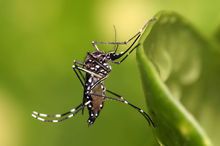With the summer months, the number of cases of mosquito-borne diseases in horses continues to increase in many areas, especially where rainfall has been persistent and wet, swampy conditions encourage breeding of mosquitoes.

Mosquito - Carrier of equine diseases
According to government reports, 53 cases of Eastern equine encephalitis and 17 cases of West Nile virus have been reported in horses in 2013 with more expected this year.
A horse in Hillsborough County, New York, has been euthanized after contracting a rare, mosquito-borne illness, and health officials are advising residents and visitors to take precautions and avoid getting bit.
The Florida Department of Health confirmed Thursday the horse had been infected with eastern equine encephalitis, most likely in mid-July.
EEE is a rare disease caused by a mosquito-transmitted virus that can cause inflammation of the brain. Only about 5 cases of EEE in humans are reported each year. It cannot be passed from person to person.
Hillsborough County has been under an advisory for mosquito-borne illnesses since March 25. The last human case of locally acquired EEE in Hillsborough County occurred that month.
In upstate New York’s rural Oneida County, West Nile Virus was confirmed on serologic samples from a yearling this past week.
A New York Department of Agriculture press release from state veterinarian Courtney L. McCracken, DVM, states that the yearling had no recent travel or vaccination history. On the morning of July 26th, the owner noticed that the yearling was lame in the left hind limb. By the afternoon, the horse was down and was paralyzed in the hind limbs by the time the veterinarian arrived.
The yearling had a temperature of 103.5 but was responsive and eating and drinking. During an initial exam, the veterinarian took samples to test for EHV-1 and began supportive treatment.
On July 27th, the owner reported improvement in the yearling, and as of August 8th, the yearling is still alive, and is now standing with some residual lack of control in its hind legs. Other horses on the premises are not showing signs of disease.
In western Massachusetts two horses have been confirmed positive for eastern equine encephalitis.
On July 26, the Idaho State Department of Agriculture (ISDA) reported that two horses, one near Parma, Idaho, and one near Meridian, Idaho, tested positive for West Nile virus..
The Idaho State Department of Agriculture recommends taking precautions to protect equines including horses, mules, burros and zebras and small camelids including llamas, alpacas, vicunas, guanacos against WNV by using fans and repellents to keep mosquitos away and by keeping livestock up to date on their WNV vaccinations.
The most common sign of WNV in horses is a fever and weakness, usually in the hindquarters; sometimes seen as a widened stance, stumbling, leaning to one side and toe dragging. Depression and other mental conditions such as fearfulness, lip-smacking, chewing movements and fine muscle tremors may be noticed. In extreme cases of WNV infection, paralysis and inability to stand may follow.
In southern states, a two-year-old horse in the Livingston Parish town of Maurepas, Louisiana was euthanized after reportedly testing positive for both West Nile virus and Eastern equine encephalitis earlier in July.
North Carolina horses were hit earlier in the summer, when six horses died after contracting Eastern Equine Encephalitis from infected mosquitoes. One horse in that state is currently reported to be recovering, according to the North Carolina Department of Agriculture. All of the reported cases have been in the southeastern part of the state – one each in Pender and Brunswick counties and five in Cumberland County.
North Carolina officials remind horse owners that symptoms of EEE in horses include impaired vision, aimless wandering, head pressing, circling, inability to swallow, an irregular staggering gait, paralysis, convulsions and death. Once a horse has been bitten by an infected mosquito, it may take three to 10 days for signs of the disease to appear.
US Department of Agriculture statistics show that in 2012, 209 equine cases of EEE were reported in 19 states, primarily in the southeast and northeast. The USDA 2012 statistics also show that, by comparison, 627 equine cases of WNV were reported in 41 states. “This was the highest number of equine cases of WNV reported in the United States in the past five years, but still considerably lower than the number of cases reported during the 2002 WNV outbreak when 15,257 equine cases were reported,” the USDA report states.
Other states with horses affected by West Nile virus this year are California with seven cases, Wyoming, South Dakota, Texas, Florida, and Ohio, with one case each. These statistics were current as of August 6th. This yields a total of 17 horses from coast to coast that have been affected by West Nile virus.
The government has also reported 53 cases of EEE in horses this year. State tallies for EEE include: 25 horses in Florida, 10 in Georgia, 4 in Alabama, and 1 each in Texas, Arkansas and Mississippi in addition to the cases in Louisiana and North Carolina.
